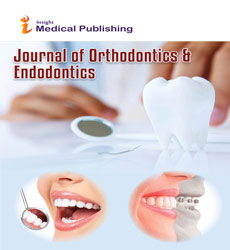Abstract
Assessment of 3�?�dimensional bone augmentation of severely atrophied maxillary alveolar ridges using patient�?�specific poly ether�?�ether ketone (PEEK) sheets
This study aimed to analyze the effectiveness of virtually designed polyetherâ?ÃÂether ketone (PEEK) sheets to delineate and maintains the threeâ?ÃÂdimensional patient's maxillary alveolar ridge.
Materials and methods: Fourteen patients (34 implants) with severely atrophied anterior maxillary alveolar ridges underwent rehabilitation using customâ?ÃÂmade CAD/CAM PEEK sheets acting as a containment system for interpositional mix of particulate autogenous and xenogeneic bone graft, fixed by monoâ?ÃÂcortical screws. Radiographic Assessment included measurements of linear changes in the vertical and horizontal dimensions on crossâ?ÃÂsectional cuts of computed tomography (CBCT) using special software.
Results: Wound healing was uneventful for all the patients except one patient that showed wound break down 2 weeks postoperatively, which did not affect the outcome of the procedure. CBCT scans were interpreted to compare the quantity of both vertical and horizontal bone preoperatively and 6 months postoperatively. Statistical analyses demonstrated a significant difference between the results of both time intervals, with a mean vertical and horizontal bone gain was 3.47 mm(±1.46) and 3.42 (±1.1) with a Pâ?ÃÂvalue of (.0001). The customized sheets were removed 6 months postoperative with the successful placement of dental implants.
Conclusion: The virtual planning of threeâ?ÃÂdimensional maxillary alveolar ridge augmentation utilizing patientâ?ÃÂspecific PEEK sheets deemed successful to restore the deficient ridge and to accommodate suitable size dental implants.
Author(s):
Ahmed Barakat
Abstract | PDF
Share this

Google scholar citation report
Citations : 265
Journal of Orthodontics & Endodontics received 265 citations as per google scholar report
Abstracted/Indexed in
- Google Scholar
- China National Knowledge Infrastructure (CNKI)
- Cosmos IF
- Directory of Research Journal Indexing (DRJI)
- WorldCat
- Geneva Foundation for Medical Education and Research
- Secret Search Engine Labs
- Euro Pub
Open Access Journals
- Aquaculture & Veterinary Science
- Chemistry & Chemical Sciences
- Clinical Sciences
- Engineering
- General Science
- Genetics & Molecular Biology
- Health Care & Nursing
- Immunology & Microbiology
- Materials Science
- Mathematics & Physics
- Medical Sciences
- Neurology & Psychiatry
- Oncology & Cancer Science
- Pharmaceutical Sciences

